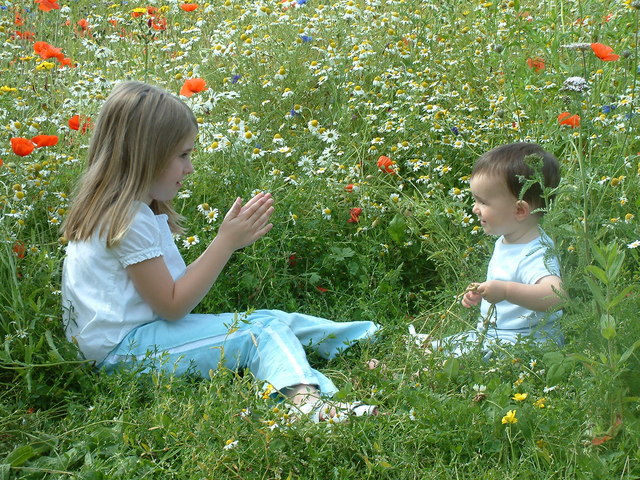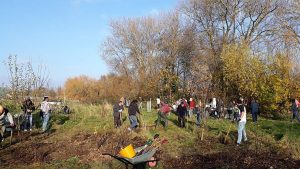Seeds
Wildflower seed merchants supply mixtures of wildflowers and grasses suitable for various soil types and situations. Choose one that suits your local conditions. Where possible obtain seed of British origin, grown by wildflower seed companies on their own land. It is advisable not to take plants from the countryside as repeated seed collecting would, over time, be likely to have a destructive effect on many species. In some cases, it can also be illegal.
Ground preparation and sowing
Strip off the top 5-10 cm (2-4”) of soil to reduce fertility as wild flowers do not compete well with grasses.
Dig or rotovate the soil, then firm and rake to make a seedbed as for a new lawn. Don’t incorporate manure or fertiliser as high fertility encourages excessive vigour in grasses that then crowd out wild flowers.
Sowing Time
Sow during March and April or in September, depending on soil conditions. On lighter soils, autumn sown seeds generally germinate and establish quickly, although some will not come up until the following spring. This delay makes it advisable to wait until March or April on heavy soils, as waterlogging may cause the seed and seedlings to rot during winter.
Even large areas can be sown by hand quite easily. Rates will vary between individual mixes but as a rough guide, pure wildflower seed should be sown at 1g per m² and wildflower and grass seed mixes at 5g per m². These tiny amounts can be difficult to broadcast evenly so mix the seed with silver sand to make it easier to handle. To further ensure that the seed is scattered evenly sow half lengthways and the remaining widthways.
Rake in lightly, water thoroughly and then leave to grow naturally. However, be prepared to protect the seed from birds if they are a problem.
Converting grassed land to wildflower meadow
Either
Mow weekly to weaken the grass and remove the cuttings. Some wild species will establish themselves and thrive and others can be planted as one or two year old pot grown plants which you have either grown yourself or have bought as plug plants.
Or
Alternatively you can take off the top soil layer and remove from site and then prepare the soil as detailed before.
If soil fertility is too high to allow perennial wildflowers to flourish, consider sowing a cornfield annual mix that includes plants such as cornflower, corn poppy, corn marigold and corncockle. Some barley and wheat seed will add an authentic touch. Sowing should be done on bare soil, free of perennial weeds. Autumn sowings generally favour poppies, while spring sowings favour corncockle.
Note: Do not sow corncockle near cropping fields.
Many plants will flower within three months of sowing, others may require a period of winter cold before they grow. Leave the plants to self seed, clear them away in spring and rake over the ground to remove weeds and encourage seed to germinate. Additional sowings may be required in the first few years until the wildflower seed bank increases.
Maintenance
Once established a wildflower meadow requires an annual maintenance programme to allow the more desirable species to flourish and to reduce the vigour of some of the more rampant species.
Watering and feeding
A wildflower area doesn’t require any additional watering or feeding. This could alter the natural balance of plants in the area. Many native flowers colonise poor ground and the addition of extra nutrients and water will encourage excessive vigour in grasses which will consequently out-compete the more desirable native plants.
Mowing
To encourage perennial flowers and grasses to make good root development, it is important to mow the meadow in the first year after sowing. Cut to a height of 5 cm (2”) four times during the year.
Established spring flowering meadows are cut in July and for the remainder of the summer to reduce the vigour of coarse grasses and to allow flowers such as cowslips, fritillary, lady’s smock, selfheal and bugle to prosper. Leave unmown from February to July. Established summer flowering meadows are not mown until late August or September after wildflowers such as knapweed, devil’s bit scabious and lady’s bedstraw have set seed. Use this summer flowering meadow regime for meadows with plants flowering at various times.
It is usually a good idea to leave the initial mowings in situ for a few days to allow seed to drop to the ground but then it is important to collect mowings to reduce soil fertility. Aim for the first cut to be 5- 7.5 cm (2-3”) high. Subsequent cuts can be lower. Many lawnmowers will struggle with long grass. Small areas can be cut with a strimmer though larger areas are best tackled with a heavy duty mower (eg sickle bar mowers and motor scythe) or a two wheel strimmer.
A new initiative #NoMowMay has been gathering momentum – it was started by Plantlife and encourages Local Authorities, Councils, Park Managers, Friends & Community Groups and anyone who looks after a growing space to:
Join legions of gardeners and say “no” to the mow this May to help our bees, butterflies, wildlife and us!
Plantlife’s No Mow May campaign doesn’t ask you to do much. In fact, it asks you to not do anything at all…
Just lock up your lawnmower on May 1st and let the wild flowers in your lawn bloom, providing a feast of nectar for our hungry pollinators.
“Plantlife – #NoMowMay“
Tackling weeds and dominant grasses
Perennial weeds, thistles and nettles for example, can either be weeded out by hand or spot treated with a weedkiller based on glyphosphate or Tumbleweed. Selective lawn weedkillers should not be used as these will kill the wildflowers you wish to encourage.
Where grasses become dominant try sowing the annual wildflower yellow rattle (Rhianthus minor) which is semi parasitic on grasses. Sow this in August and keep the grass mown until March.
Inspiration
If you want to head somewhere and see some fabulous and well-managed wild flower-rich meadows and grasslands, then take a look at ‘Coronation Meadows‘ – this project started in 2013 and aims to protect ancient meadows and/or plant a wildflower meadow in every county to celebrate the 60th anniversary of the Coronation. From an idea by HRH The Prince of Wales, the scheme was created and is now managed by Plantlife in partnership with The Wildlife Trusts and the Rare Breeds Survival Trust. You can use their interactive tool to ‘Find A Meadow Near You‘. We have lost a staggering 97% of our British meadows, if parks and green spaces across the country can do their bit, then maybe together we can start to rectify this alarming loss of biodiversity.
The Coronation Meadows scheme aims to create new meadows at ‘recipient’ sites in the same county, using the Coronation Meadows as source or ‘donor’ meadows to provide seed:
Recipient Meadows are selected by the project technical group and verified against agreed criteria to ensure that they are suitably representative of the habitat type, conditions and geographical area exhibited by the donor meadow in order that they stand the best chance of thriving and are conserved for the future through sympathetic management.
https://coronationmeadows.org.uk/about/
Further sites can be nominated by members of the public to become “People’s Meadows” and will be featured and promoted on the Coronation Meadows website:
They encompass a range of sites; many with public access, some historic and others modern. Whilst the submissions are not verified against the criteria of this project they remain valuable places for people to enjoy our wonderful flora. Let us know about a meadow near you…
https://coronationmeadows.org.uk/about/
Suppliers
The National Wildflower Centre at Knowsley in Merseyside. www.nwc.org.uk

Reproduced with permission of North West Parks Friends Forum







